Families on the Border Join the Fight Against Diabetes
November 2006
Spanish Version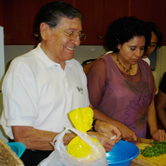
Felix Lopez, 74, left, cooks a healthy meal with his family members during a Diabetes and the Family class.
Felix Lopez, 74, learned six months ago he has diabetes.
It didn't come as a shock to him. He had been feeling tired, and in his town of Douglas, Arizona, on the U.S.- Mexico border, almost 22% of people aged 40 years and older have diabetes—a higher rate than in most Latino communities and much higher than the U.S. average.
But what he did afterward was something new.
He invited his wife and daughter to a class on how to control and prevent
Type II diabetes and its complications. In the class, held at a local
church, the Lopez family talked with two other families and a promotora, or
a lay health adviser, about the importance of eating a healthy breakfast
every day and ordering low-fat dishes in restaurants. They danced the
salsa in a conga line around the building, with the grandson of one
participant leading the way. Then, they all worked together to make a dinner
of chicken tostadas, vegetables, and fruit salad, which they shared around a
table.
Mr. Lopez says he is feeling better. He did a handstand in the church's
kitchen to prove it.
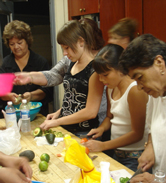
Family members of all ages work together to prepare vegetables and fruit for dinner during a Diabetes and the Family class. Listen as Kerstin Reinschmidt, of the Southwest Center for Community Health Promotion, discusses the importance of involving the family in the diabetes intervention. Read Transcript.
Streaming Audio Format. You will need RealPlayer® to listen to this file.
The class is part of a program run by the Southwest Center for Community Health Promotion, one of 33 Prevention Research Centers funded by the Centers for Disease Control and Prevention. The center is housed at the University of Arizona's Mel and Enid Zuckerman College of Public Health. Researchers hope to show that involving families, communities, and promotoras in the comprehensive care of a person with diabetes leads to better health outcomes than a traditional approach to care in which a patient only discusses the disease with his or her physician.
Diabetes is a disease that keeps the body from properly regulating sugar, and the Type II form, which continues to grow in prevalence in the United States, is associated with overweight. Healthy diets and regular exercise have been shown to improve the health of people who already have the disease. When untreated, diabetes can lead to complications in the eyes, heart, kidneys, nerves and feet, and it is also associated with depression.
Researchers say this intervention will not only help patients but could also inspire family members, friends, neighbors, and concerned community members to live healthily and prevent diabetes from developing in themselves.
"For diabetes, we know that lifestyle changes can prevent or delay the onset," said Lisa Staten, PhD, director of the Southwest Center for Community Health Promotion. "We've got to figure out how to work with communities so that they know and believe that."
The center employs four promotoras in Douglas who teach nutrition, physical activity, and disease prevention in a 5-week class for families, Diabetes y la Unión Familiar (Diabetes and the Family), and a 12-week class for community members, Pasos Adelante (Steps Forward). Both are held at local churches. A fifth promotora, paid for by the local Chiricahua Community Health Center, a partner of the university, helps a registered nurse teach a 4-session program to health center patients with diabetes. All the classes are free. Researchers are tracking outcomes such as weight, body mass index, blood sugar and cholesterol levels, diet, exercise, and other health behaviors to see how much each of the three interventions helps and what the effects are of combining more than one intervention. They are also working with the community to enact lasting policy changes that will keep people in the region stay healthy.
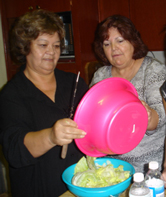
Promotora Lourdes Fernandez, right, assists a participant during a
Diabetes and the Family class. Listen to Ms.
Fernandez discuss being a promotora.
Read transcript.
Streaming Audio Format. You will need
RealPlayer®
to listen to this file.
Mr. Lopez, who moved to the United States from Mexico 40 years ago, calls promotora Lourdes Fernandez, "my guardian angel." She put him in touch with a dentist and an eye doctor and helped him find appropriate shoes to protect his feet. He began an hour of walking every day at 6 a.m. He also started to drink more water, essential to help his body regulate sugar. But he said that while he feels much better, change hasn't been easy.
"It's very difficult to change your habits, the way you have lived all your life," Mr. Lopez said.
That sentiment is common among patients and health care providers both—changing health behavior is much more difficult than taking a pill.
"Trying to get someone to change their diet is huge," said Ginger Ryan, CEO of the community health center. She said while some traditional Hispanic foods can make up a healthy diet, other foods such as high-carbohydrate tortillas, beans, cheese, and eggs can be troublesome for people with diabetes because the body quickly converts them to sugar.
But while some cultural factors, such as diet, may contribute to the high rates of diabetes in Hispanic communities, other cultural factors such as close extended families might help stop the epidemic. Researchers are counting on close-knit networks of neighbors to pass on tips and help each other stay healthy.
On a recent morning, five women who have participated in the Pasos Adelante program over the past year gathered with Ms. Fernandez, the promotora, to talk about how the class changed their lives.
Maria Lamadrid, 39, didn't think the class was for her, even though her father died of diabetes complications. Then a doctor told her her cholesterol level was high, and she enrolled. The class explains how cholesterol, blood pressure, diabetes, and heart disease are related. Ms. Lamadrid started paying attention to the types of fats she was eating. She cut out soft drinks and now drinks only skim milk. She brought her 6- year-old son Francisco to the classes, and he exercises with her. She also brought 10 co-workers from the restaurant where she works. After her session was over, she referred 8 more people to the next one.
Having so many people around her who are also taking the class creates a huge support group, she said. "When sometimes I don't feel like walking, my husband will say, come on, let's walk," she said. "I feel very well and want everyone to feel well too."
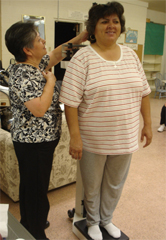
Promotora Blanca Robles measures the height and weight of Pasos Adelante participant Maria Arballo.
Irma Camacho, 53, lost 20 pounds during the class and so did her husband. "In the past I had a lot of problems getting him to eat a salad on the side," she said of her husband. "Now we're both eating more salad. We stopped eating flour tortillas, we use corn tortillas and whole wheat bread. There are a lot of changes in the house now."
But it was more than that for her; the class helped her mental state too. Ms. Camacho has lupus and also had a long and difficult recovery from an infection after knee surgery. She was in a wheelchair for 5 years, and she became depressed and obese. "I didn't want to go anywhere," she said. "Always, I was crying and crying and crying."
Since she started the class, she's been walking a few steps at a time and can now walk almost half a block. She does exercises at home, and her cholesterol and blood pressure levels have improved. She and her husband decided to repeat the class after their session ended.
"We're going to be here until Lourdes says, 'We're going to kick you out.'" she said.
It's not that the women didn't know what was or was not healthy to eat, or that exercise is important, they said. "We knew what's good and what's bad," explained Mary Grijalva, 64. "But being in a group really helped." Click here to hear Ms. Grijalva discuss the changes she's made since taking the class. Read transcript. You will need RealPlayer® to listen to this file.
And in at least one case, the group learning may have saved a life. Carla Chavez, 60, is the caretaker for her sister Rosa, who has diabetes. In the class, Ms. Chavez learned how to test blood sugar using a finger-prick test. She knew what to look for one day when her sister appeared sick and couldn't swallow. Ms. Chavez measured her sister's sugar and found it was dangerously low. Ms. Chavez immediately called a promotora, who told her to call an ambulance. "Right away, my reaction is really fast because I learned in the class," she said.
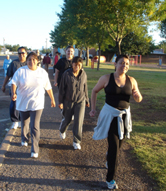
The Pasos Adelante walking group heads out at 6:30 a.m. in Douglas, Arizona. Enlarge picture.
Ms. Fernandez was a nurse in Mexico before she moved to the United States 25 years ago. She said the kinship she feels with the patients and participants helps them to trust her. Everyone agrees the promotoras are the heart of the program.
"We are talking the same," Ms. Fernandez said. "That is the main thing, the trust they place in you because you are there to help. As long as you gain that trust in the community, you are a resource."
Promotoras Blanca Robles and Martha Barrerra not only teach the community classes on Tuesday nights but on three mornings a week they walk at 6:30 a.m. with all the class participants. The oldest is age 82. On one Tuesday morning, 20 people gathered at dawn to walk a circular path around a park as the sun rose above the mountains.
"I did two turns without even thinking about it," said one participant who visited with her sister-in-law while walking.

The border divides the towns of Douglas, Arizona, on the left, and Agua Prieta, Sonora, Mexico on the right. The two cities act as one metropolitan region, according to locals. Enlarge picture.
Researchers say that people in the border region, a swath of land about 60 miles north and south of the U.S.-Mexico border and 2,000 miles long—from California to Texas—face challenges when it comes to health because of few resources. If the U.S.- Mexico border region were a state, it would be the one with the highest poverty level, said Jill Guernsey de Zapien, associate dean of the school of public health at the university and a longtime border health researcher. The physical line cuts metropolitan areas in half, and each side is under a different country's control, with different laws, infrastructure, and health care systems. Many area residents have family on both sides and go back and forth, which makes consistent health care problematic.
The Southwest Center for Community Health Promotion, based in Tucson, began doing research in Douglas in 1996. The center hired promotoras to conduct a survey that found an extremely high level of diabetes in the area. The researchers got to know the community, which started the Douglas Diabetes Work Group, and together the collaborators sought and received grant money for rural health outreach. In 2000, the center used federal grants to expand to two border counties, Santa Cruz and Yuma, and began the family and community interventions. In 2005, they brought the program back to Douglas, added the patient intervention, and began rigorously measuring results. Scientific outcomes are expected to be known within a year.
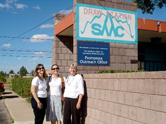
Lisa Staten, Anne Hill, and Jill Guernsey de Zapien, of the Southwest Center for Community Health Promotion, stand outside the center's promotora outreach office in Douglas, AZ. The center, one of CDC's 33 Prevention Research Centers, is housed at the University of Arizona's Canyon Ranch Center for Prevention and Health Promotion. Enlarge picture.
"Our experience has been in working with coalitions that transform themselves into action-oriented groups," said Joel Meister, PhD, a professor with the center who studies policy and works closely with the SAGs.
"We kind of play the role of community developers, full partners," Dr. Meister said. "We really focus the community on the whole issue of environmental shift and policy change as the next obvious step. For health promotion ultimately to be effective and to reach a broad part of the community, it has to go beyond traditional boundaries."
The community involvement is important because without it programs might not continue after the researchers have to leave, Dr. Staten said. "It's very shortsighted if you don't work with communities. That's our only hope of sustainability. These communities are fighters."
![]() One or more documents on this Web page is available in Portable Document Format
(PDF). You will need Acrobat
Reader (a free application) to view and print these documents.
One or more documents on this Web page is available in Portable Document Format
(PDF). You will need Acrobat
Reader (a free application) to view and print these documents.
- Page last reviewed: December 10, 2008
- Page last updated: November 17, 2007
- Content source: Division of Adult and Community Health, National Center for Chronic Disease Prevention and Health Promotion
Get email updates
To receive email updates about this site, enter your email address:
Contact Us:
- Prevention Research Centers
4770 Buford Hwy, NE
MS K-45
Atlanta, GA 30341-3717 - cdcinfo@cdc.gov

